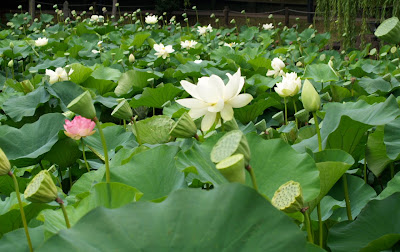

The introduction of Buddhism to China brought with it the significance that the lotus had acquired in India where it is an integral part of the worship of Brahma who is sometimes represented seated on a lotus flower arising from the navel of Vishnu who floats on his back in the ocean. To the Buddhists, the lotus symbolises the perfect or princely man, rising up from the mud, reaching up to the light and there revealing a stainless purity and integrity, undefiled by the darkness it has traversed. It also represents the three stages of existence...... past , present and future , by the fact that the buds ,flowers and seed pods are present at the same time. In China, it is grown in most gardens, often in porcelain containers in courtyards and it has come to represent the principal symbol of summer.
The lotus occurs naturally in Asia from Iran to Japan and south to the northern parts of Australia. Despite being native to the warmer regions of the world it is remarkably cold tolerant, though in places with freezing winters it is often lifted at the end of the season and the tuberous roots are stored in a cellar for replanting in spring. The North American species N. lutea has been used in crossbreeding to produce more cold tolerant forms and the most successful of these is the cultivar Mrs Perry D Slocum which has creamy yellow to pink flowers.
Lotuses are not difficult to grow, though you need to allow a square metre per plant and at least 20 cm of water over them. Propagation is by division of the tubers in spring and they do require an appropriate waterlily fertilizer to promote good flowering. Almost every part of the plant is edible. The seeds can be eaten raw or cooked, the tubers can be sliced and used in stir fries and the leaves can be used to wrap foods before steaming. They are spectacular plants in the garden and when it rains on the lotus pond you can watch the raindrops dance like quicksilver over the leaves.



Thanks, Ian for so much information. Although it is a wild flower which grows in many village ponds, I have never been able to get a good picture of the lotus.
ReplyDeleteThe lotus flower is also a significant part of the Hindu culture and religion. In India, the lotus flower is heavily associated with Hindu divinities like Vishnu, Lakshmi, and Sarasvati. Of these three divinities, Vishnu is the most prominent to be associated with the lotus flower.Lotus flower
ReplyDeleteThanks tom for your interesting comments cheers Ian
Delete